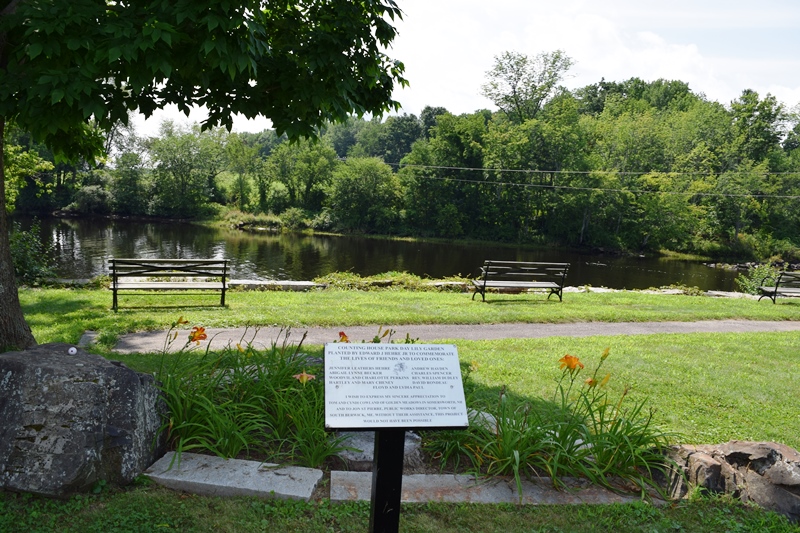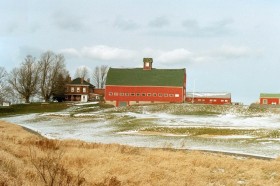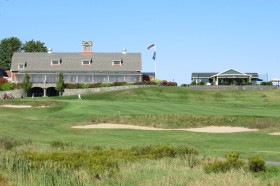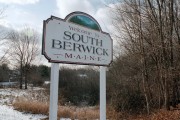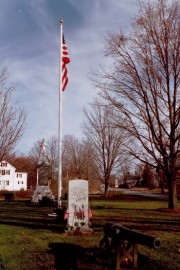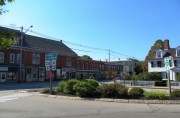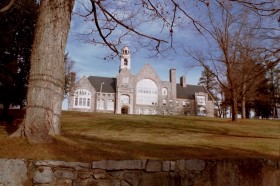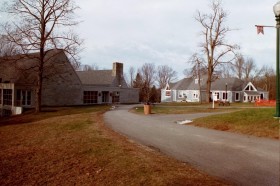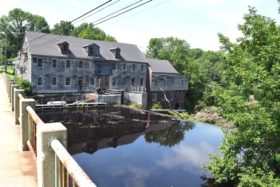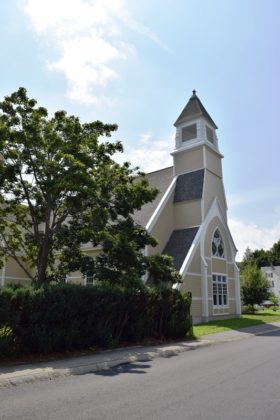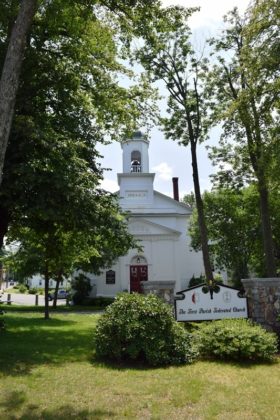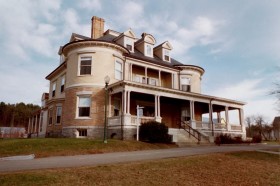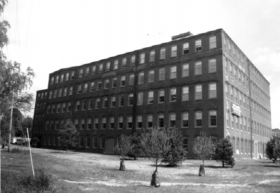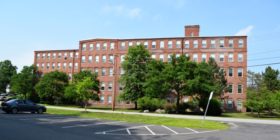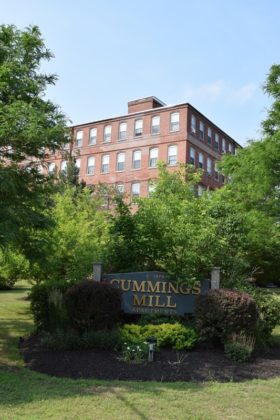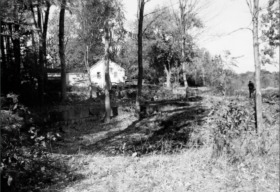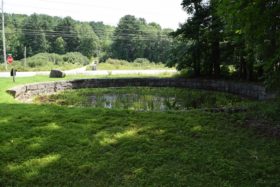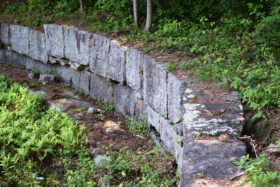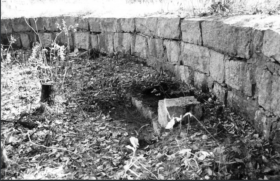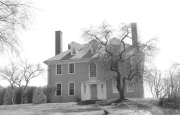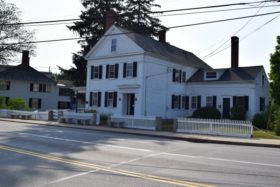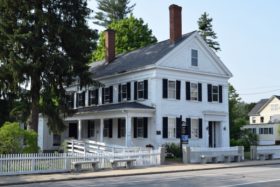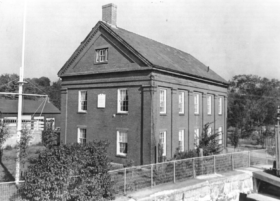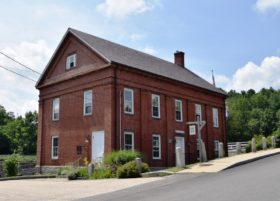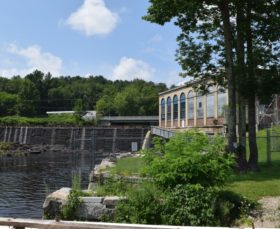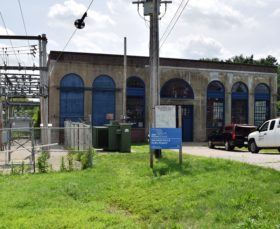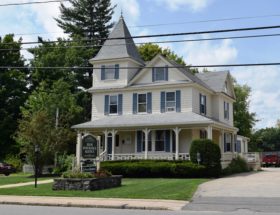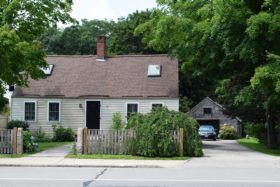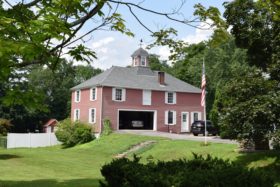| Year | Population |
|---|---|
| 1970 | 3,488 |
| 1980 | 4,046 |
| 1990 | 5,877 |
| 2000 | 6,671 |
| 2010 | 7,720 |
| Geographic Data | |
|---|---|
| N. Latitude | 43:14:32 |
| W. Longitude | 70:44:45 |
| Maine House | Dist 2,6 |
| Maine Senate | District 35 |
| Congress | District 1 |
| Area sq. mi. | (total) 32.7 |
| Area sq. mi. | (land) 32.2 |
| Population/sqmi | (land) 224.2 |
County: York
Total=land+water; Land=land only |
|
[South BER-wik] is a town in York County, incorporated on February 12, 1814 from a portion of Berwick, which was named for an old English town.
It annexed land from York (1834) and from Berwick (1841, 1881).
It was settled in about 1624 at a time when the Indians were still living at Quanpegan Falls, “dip net falls” or “the place where fish are taken in nets.” Below the falls, the salmon were trapped using weirs.
Salmon Falls River, which marks the town’s and the state’s boundary with New Hampshire, was named for this fishing place.
The first sawmill in America was built on the Great Works River, a tributary to the Salmon Falls River, in 1650.
Maine’s oldest educational institution, Berwick Academy, was established here in 1791 when the town was part of Berwick. North Berwick abuts Berwick.
Once a boarding school, this private school now is a daytime K-12 school serving southern Maine and New Hampshire.
Many other historic sites may be found throughout the community.
South Berwick is the birthplace of Sarah Orne Jewett, who attended Berwick Academy for four years — her only formal education. She remained in the town virtually all her life.
The town is accessible to the coastal communities of York and Kittery via Maine Routes 91 and 236.
Berwick Academy Grounds (2001)
South Berwick once had an active mill complex beginning in the 18th century. Located on the Great Works River at the “Rocky Gorge”, some of the mills were active until the mid-20th century. The remains of the complex are at the Great Works Bridge on Brattle Street, from which this photo was taken in 2018.
Several other early buildings grace the town that was one of the first settled towns in what is now Maine. The 1702 and 1929 First Parish Federated Church is one of those. A more recent building is the former St. Michael’s Church, which is now the South Berwick Public Library located in the downtown area.
John Holmes Burleigh (son of William Burleigh; also a U.S. Representative), was a U.S. Representative in Congress. He was born in South Berwick, October 9, 1822 and, according to his biography, “attended the local academy.”
Government: Town Meeting-Council-Manager.
Additional resources
Carroll, Gladys Hasty. Wings of Berwick Academy Over the Township of South Berwick and its Neighbors (Late 1800’s and early 1900’s). South Berwick, Maine. Dunnybrook Historical Foundation. 1992.
Frosst, George Washington. Quamphegan Landing. South Berwick, Me. Old Berwick Historical Society. 2001.
Hilton, Fannie Mulloy. Memories of a Little Country Church, or, A brief History of the South Berwick and Wells Christian Church. South Berwick, Me. F.M. Hilton?. 1969. (Chronicle Print Shop)
Jewett, Mary Rice. South Berwick Village and the Fire of 1870. South Berwick, Me. Old Berwick Historical Society. c2002.
*Maine. Historic Preservation Commission. Augusta, Me. Text and photo from National Register of Historic Places: http://pdfhost.focus.nps.gov/docs/nrhp/text/xxxxxxxx.PDF, http://pdfhost.focus.nps.gov/docs/nrhp/photos/xxxxxxxx.PDF
Pirsig, Wendy K. The Placenames of South Berwick. Old Berwick Historical Society. Portsmouth, NH. Back Channel Press. c2007.
Seaver, Josiah W. Papers, 1839-1845. (Cataloger Note: Josiah W. Seaver was a resident of South Berwick, Maine. He was a graduate of Dartmouth College, served two terms in the Maine Senate after 1820 and was in the Maine House of Representatives in the 1830s. He also served as revenue collector of the 8th Massachusetts District and was sheriff of York County, Maine, in 1824.) [University of Maine, Raymond H. Fogler Library, Special Collections]
National Register of Historic Places – Listings
Berwick Academy
[Academy Street] Berwick Academy historic district is important for the history and architectural merits of the individual buildings, and the significance of Berwick Academy in the educational history of Maine.
In 1790 the citizens of Berwick, Wells and York raised five hundred pounds in each town to help establish the Academy. Judge Benjamin Chadbourne donated ten acres in South Berwick for the school. The land had been purchased by his grandfather Humphrey Chadbourne from the Newichawannock Indians in 1623, and has the oldest recorded deed in Maine.
On March 11th, 1791 the charter for Berwick Academy, the first in Maine, came from Boston. It was signed by the Governor of Massachusetts, John Hancock. The 1791 House was built for housing and classroom space, functioning in those two capacities until outgrown in 1823. Finding 1500 pounds, raised by the citizens, insufficient to run the school, Berwick Academy was given a 23,000 acre endowment in 1792. Granted by the Massachusetts legislature on the condition of immediate sale, this land in the Kennebec Valley (now-Athens) was sold for $4,400.
The expenses for the Academy included 500 pounds to build the 1791 House, and 90 pounds for the salary of the first headmaster, Samuel Moody. He also was given the right to assess each student six pence a week to supplement his income. The finances of the institution were seriously damaged, however, when 142 pounds were lost in a fire at the home of the treasurer, Dr. Ivory Hovey.
The 1791 House, the oldest secondary school building in Maine, was sold for $500 in 1823, and was moved to Main Street to become a private residence. Originally an all male school, Berwick trustees voted in 1797 to admit females. No girl took up on the offer, and it was rescinded in 1813. The trustees again voted to admit women in 1828. This time four women availed themselves of the privilege. Although they were officially attending the Berwick Female Seminary, the buildings and the faculty were the same. In 1854, the women were awarded Berwick Academy diplomas as they have been ever since.
The Academy again hit financial hard times in 1817 and was forced to close until 1819. In 1828, the trustees appropriated $1,600 for a new building, if that figure could be matched by outside contributors. Judge William A. Hayes led the funding effort which succeeded in raising $1,700, $500 from Hayes himself. Unfortunately, this building burned in the “Rum Rebellion” in 1851.
Hon. Francis B. Hayes, son of Judge Hayes, was put in charge of obtaining plans for a new building. These were drawn by noted architect Richard UpJohn of New York. The new building was dedicated in December 1853.
Between the fire in 1851, and the completion of the new building in 1853, the Academy held its meetings in the town. The benevolence of the Hayes family continued. Members served as fundraisers, presidents and trustees. Also remembered for establishing the Fogg Museum at Harvard, Hayes philanthropy was again bestowed on Berwick Academy in 1892. In that year, Mrs. Elizabeth Perkins Fogg left $50,000 to the Academy in memory of her husband who had been a student at the Academy. Two other members of the family also contributed.
The Fogg Memorial building was built in 1894 to replace the 1853 Academy building and house the library and classrooms. George A. Clough, a Boston architect and native of Blue Hill, drew the plans for this beautifully sited and grandly conceived Romanesque Revival building. The stained glass windows of the Fogg Memorial were designed by Sarah Whitman, a noted Boston artist and a friend of Berwick’s distinguished alumna, Sarah Orne Jewett. In the 20th century, Berwick Academy enlarged its program to include the curriculum of a comprehensive high school of its own and the Academy served the Berwick area.
In the mid-1950s a serious attempt was made to strengthen the college preparatory course, and the school facilities. In 1964, the original 1791 House was returned to the Academy campus to be the oldest original frame schoolhouse in active use for school purposes in the United States. The Dunaway House, now the Headmaster’s residence, was acquired by the Academy in 1968. This handsome Federal house of 1811 contains exceptionally fine French pictorial wallpaper of the 1830s.
After 1894, the Fogg Memorial library was open for public use. Berwick Academy remains a living monument to the heritage of education, and to the citizens who served their community by supporting it.* [See 2001 Berwick Academy Grounds photos above]
Cummings Shoe Factory
[Railroad Avenue, South Berwick] The Cummings Shoe Factory was a successful part of Maine’s shoe industry for almost 120 years. Built largely between 1871 and 1891, the five story brick structure was surrounded by support shops, including a tannery and stables, as well as tenement housing for workers. It was a key employer and economic contributor to South Berwick. Although stripped of these ancillary structures by its closing in the early 1990’s the factory building remains. It was remodeled with 48 residential apartments.
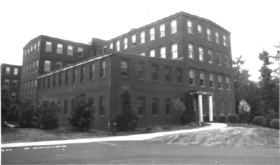 In 1871 a Worcester, Massachusetts shoe manufacturer built one of the largest brick shoe factories ever built in Maine. The South Berwick Cummings Factory also included a box factory, stables for transporting goods, and extensive worker housing. Cummings built his first shoe factory in Lynn, Massachusetts then established a two-story wooden plant in Springvale around 1864. His decision to build in South Berwick was clearly in response to the increasing strength of labor unions in his home state.
In 1871 a Worcester, Massachusetts shoe manufacturer built one of the largest brick shoe factories ever built in Maine. The South Berwick Cummings Factory also included a box factory, stables for transporting goods, and extensive worker housing. Cummings built his first shoe factory in Lynn, Massachusetts then established a two-story wooden plant in Springvale around 1864. His decision to build in South Berwick was clearly in response to the increasing strength of labor unions in his home state.
Unlike other shoe factories in Maine, the Cummings attempted a horizontal integration which may have contributed to its success. A brick addition was devoted to tanning operations, while a wooden building nearby was used to assemble boxes for the shoes.
At the turn of the 20th century the 350 employees of the South Berwick plant were capable of making up to 5,000 pairs of shoes a day, in what David Cummings hoped to be “the most complete factory in the country….with every up to date and improved equipment for making shoes.” David Cummings died in 1910. The business was passed onto his nephew William I. Cummings under whom it continued to thrive for two decades.* [Amy Cole Ives photos, 2001]
Cummings Mill Apartments was a residential space in 2018.
Conway Junction Railroad Turntable Site
[Fife Lane and Route 236] The 1855 Conway Junction Railroad Turntable is the most visible remaining structure associated with the Great Falls and South Berwick Railroad, a short branch line that connected Great Falls, New Hampshire with the Portland, Saco and Portsmouth Railroad (P, S and P). South Berwick has had a long association with the growth of railroads, beginning with the founding of the Portland, Saco and Portsmouth , chartered in 1837. Building the road began in 1841 and was completed the next year. In 1843 the Boston and Maine Railroad met the P, S and P in South Berwick, establishing the town’s railroad ties. Twelve years later the three mile long Great Falls and South Berwick line was built between Conway Junction and Great Falls, New Hampshire where it intersected with the Boston and Maine. This created a triangular web of rail lines across the northwestern corner of South Berwick.
The Great Falls and South Berwick made its base at Conway Junction where it built the turntable and engine house. Throughout the late 19th century the facility at Conway Junction was used as a fueling station and minor engine maintenance shop. In 1910 it was renamed the Jewett Junction. The last scheduled train departed from here in 1936, and five years later the line was abandoned.
Later a state highway was built over the rail bed of the old P, S and P line as well as that of the Great Falls and South Berwick. The turntable site survived by virtue of its location away from the new road, but the movable table and the engine house were removed. Nevertheless, it continues to be an important physical reminder of the prominence of railroads in South Berwick’s past.* [Kirk F. Mohney B&W photos, 1987]
Hamilton, Jonathan, House, National Historic Landmark
[Vaughan’s Lane and Old South Road] Still in its beautiful and undisturbed rural setting, the 1788 Hamilton House is a magnificent and little-altered example of a large New England frame Georgian country house. Jonathan Hamilton, a Portsmouth, N.H. merchant, bought this land at Pipe Stave Point on the Piscataqua River in 1783 and built this large house, his residence until his death in 1802. [National Park Service photo]
The house stood vacant from 1815 until 1839. In 1898 it and 110 acres were acquired by Mrs. Emily D. Tyson, who made minor structural changes. In 1949, Mrs. Henry G. Vaughan, Mrs. Tyson’s daughter, willed Hamilton House and 50 acres, along with income from a trust fund, to the Society for the Preservation of New England Antiquities, which restored the mansion to its original features.*
Jewett, Sarah Orne, House, National Historic Landmark, Maine Routes 4 and 236. [See Sarah Orne Jewett]
Jewett-Eastman House
 [37 Portland Street] The Greek Revival Jewett-Eastman House was the home of a distinguished practicing and teaching physician and his daughter, Sarah Orne Jewett. The house was built between 1849 and 1855 for Theodore Herman Jewett, M.D. Jewett was a graduate of Bowdoin and of a Philadelphia medical school. He served as a professor of obstetrics at Bowdoin, contributed many articles to medical journals, and was president of the Maine Medical Society for many years.
[37 Portland Street] The Greek Revival Jewett-Eastman House was the home of a distinguished practicing and teaching physician and his daughter, Sarah Orne Jewett. The house was built between 1849 and 1855 for Theodore Herman Jewett, M.D. Jewett was a graduate of Bowdoin and of a Philadelphia medical school. He served as a professor of obstetrics at Bowdoin, contributed many articles to medical journals, and was president of the Maine Medical Society for many years.
After his death his daughter Sarah donated a stained glass window in his memory to the Bowdoin College chapel. She dedicated Country By-Ways to her father, wrote two poems about him after his death, and made him the protagonist of her Country Doctor novel.
Jewett and his family lived in this house for some twenty years. When his youngest daughter, Caroline, married Edwin Eastman, it became their home. Their only son, Theodore Jewett Eastman, M.D., a graduate of Harvard and Harvard Medical School, grew up in this house, as did his famous Aunt Sarah.
Upon Dr. Eastman’s death in 1931, both Jewett houses became the property of the Society for the Preservation of New England Antiquities. The Jewett-Eastman House is of inestimable value to South Berwick and to Maine, not only because its current life as a library is a most fitting use for an author’s home. The house is an inseparable partner of the Sarah Jewett Memorial. Together on the village square they set the atmosphere for the entire town.* [Frank A. Beard photos, 1983]
Portsmouth Company Cotton Mills: Counting House
[Maine Route 4 at Salmon Falls River] Industry came early to the Berwick area with the construction of a substantial sawmill operation at Great Works, on the Piscataqua River in 1660.
The Counting House is the last surviving building of the Portsmouth Company Cotton Mills at Quamphegan Falls Landing, in South Berwick. It is evidence of the once vital industries which animated so many small New England towns in the 19th century, and which have now vanished, bankrupt or moved to the South. The building is also a handsome example of Greek Revival industrial architecture.
The Portsmouth Mill, established in 1832 was for many years under the guidance of Portsmouth-born entrepreneur, Samuel Hale.
The Portsmouth Company’s works was one of several mills the Berwick area producing a variety of goods including cotton textiles, woolens, shoes, and other leather products. But like so many New England textile mills, especially the small ones, the Portsmouth Company moved its Berwick operation South at the turn of the 20th century. The Counting House is now the headquarters of the Old Berwick Historical Society, which has done much work to restore the building.* [Earle G, Shettleworth, Jr. photo, 1975]
The setting for the Counting House is a small park in the Salmon Falls River. It is adjacent to a hydro power dam serving the South Berwick electric power project.
South Berwick Village Historic District
[Portions of Main, Portland, Highland and Academy Streets] Settled in 1624 and containing almost 14,000, mostly rural and suburban acres, the densest concentration of commercial, civic and residential buildings are found in South Berwick village, just inland of the Salmon Falls River in the northwest corner of the town.
The river forms the boundary between New Hampshire and Maine, and historically was the location of the earliest settlement in the town.
The District is several blocks northeast and east of the River and comprises most of Main Street and Portland Street and parts of Highland Avenue, Agamenticus Road and Academy Street. This late 18th and 19th century commercial and residential center developed along an important regional transportation corridor known as the former Dover Turnpike or the Boston-Portland Post Road.
The District contains a variety of of domestic, commercial, and civic architecture, including most of the nationally and regionally prominent architectural styles popular from the end of the Colonial era through the first World War. In the late 18th and early 19th centuries, a substantial collection of Georgian and Federal style houses were built along Main and Portland Streets, often by prominent citizens.
Portland Street: George W, Goodwin, Jr. was a Civil War veteran who built his Queen Anne style house. Micajah Currier’s is one of the earliest houses on the street. A local businessman with interests from Portsmouth to North Berwick, he also owned a store at the corner of Portland and Main Streets. The post-and-beam Nason-Walker barn was part of an estate owned by merchant Bartholomew Nason in the last years of the 18th century. Nason was a merchant who owned a store with his son Benjamin at The Corner starting c. 1800. Benjamin Nason had an important role in the formation of South Berwick in the 19th century, with the construction of the the First Church of Berwick in 1826 and other activities.
Greek Revival domestic architecture is represented in the district by at least nine houses and several commercial and religious buildings. When Highland Avenue was laid out between 1872 and 1877 houses built there were some of the best local examples of high-style architecture in the Stick, Second Empire and Queen Anne styles. The Sarah Orne Jewett House and Jewett-Eastman House are in the District.*


